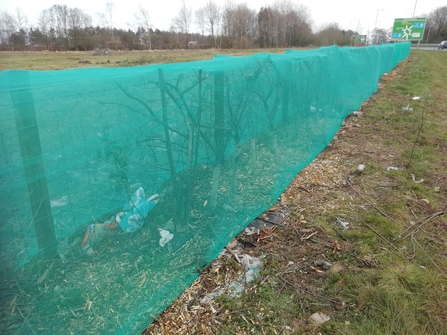
Example of bird netting over hedges in Cumbria
Gifting membership? Order by Wednesday 17 December in time for Christmas.

Example of bird netting over hedges in Cumbria
Every day we hear reports of how wildlife is in decline so it’s vital that we all play our part in bringing our wildlife backStephen Trotter, Chief ExecutiveCumbria Wildlife Trust
Cumbria Wildlife Trust is very concerned about the increasingly common practice of netting hedgerows to stop wildlife nesting or using this habitat ahead of development and we advise against its use.
Netting can trap and injure birds, mammals, insects and other wildlife and we urge developers to take more care to protect wildlife during construction. We remind developers that they have an obligation to consider the impact of a project on local wildlife and, where necessary, take precautionary steps to protect habitats and wildlife.
We are now aware of eight sites across the county where netting is being used (as at 12 April 2019). One site in Ulverston seems to have had netting in place for over two years.
We believe that if hedgerow removal must happen and has planning permission, it should be planned to be done outside the bird breeding season. This would mean there is no chance of birds having active nests and hence there should be no need to use nets.
We acknowledge that in exceptional circumstances, the use of netting may be necessary but in the vast majority of cases, with good planning and competent ecological advice, the need for nets can easily be avoided.
Cumbria Wildlife Trust works across the county to influence planning developments. We seek to improve the environmental quality and value of developments for developers, people and wildlife by minimising damage to wildlife and maximising the creation of new habitats. As part of this we always suggest that existing habitats such as hedges be kept wherever possible and are woven into new developments. We hope this will become standard practice as new building rules to deliver wildlife gains come into effect.
The Trust strongly supports new Government policy that all development should be required to deliver significant net gains for biodiversity so we leave our environment in a better state than we found it.
Stephen Trotter, Chief Executive of Cumbria Wildlife Trust said:
“We know wildlife is in trouble across the UK and even here in Cumbria. Every day we hear reports of how wildlife is in decline so it’s vital that we all play our part in bringing our wildlife back. Our planning system and development plays a vital role in not only reversing the declines but in putting nature into recovery. We encourage developers to do the right thing for wildlife and the evidence shows that it makes for better development for everyone when they do so.”
“Many developers are doing the right thing and can demonstrate how development, people and wildlife can benefit from integrated design and planning (see the Wildlife Trusts' 'Homes for People and Wildlife'. I welcome the positive approach that many developers and local authorities are taking, for example, at the proposed Garden Town south of Carlisle – we need more of this.”
“But in our view, netting is an overly simplistic approach and there is an understandably negative reaction from both the public and from professional ecologists to the real and potential harm that it may cause to wildlife.”
We believe tree and hedge removal should be completed outside of nesting season. However, if there is absolutely no alternative, then netting must be used sparingly in line with the legal duties and responsibilities on developers, including regular checks to ensure wildlife isn’t getting trapped, injured or worse.
If work is absolutely necessary, then the use of netting could be avoided by tree- and hedge-removal being completed outside of nesting season, backed up by a commitment to plant new trees and hedges. We encourage the government to review the current law governing this area, and think creatively about what could be done to solve a problem that is upsetting so many people and excluding wildlife from our neighbourhoods.
While the practice of netting is legal, we support the advice agreed recently by the RSPB and the Chartered Institute of Ecology and Environmental Management (CIEEM). We strongly recommend that developers and local authorities in Cumbria follow these guidelines.
This advice recognises that “Whilst not illegal, we have considerable concerns about the use of this practice and we advise against its use.”
Forward planning and early engagement of a competent ecologist by developers can often mitigate the circumstances that require netting to be used and avoid unnecessary delays to development projects.
Our planning system and development plays a vital role in not only reversing the decline in wildlife but in putting nature into recoveryStephen Trotter, Chief ExecutiveCumbria Wildlife Trust